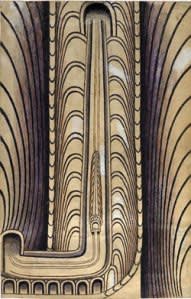The recent discovery of 130-some drawings by Martín Ramírez (1895-1963) has been likened to the unearthing of Tutankhamen’s tomb. The scrabbled fantasies of a schizophrenic and the roots of civilization—how could they not be equally important?
Hype knows no bounds, but the Ramírez find is a pretty big deal. Long known to aficionados of outsider art, his drawings were the subject of a retrospective last year at the American Folk Art Museum. Ramírez’s vertiginous tableaux of caballeros, animals and preternatural, zooming trains prompted far-reaching accolades. The Times claimed him as “one of the greatest artists of the twentieth century.” Watch your back, Matisse.
Ramírez emigrated from Mexico to the United States in 1925. Looking for jobs in Northern California, he worked in the mines and for the railroad, but not for long. He was arrested and hospitalized for “catatonic” behavior. Ramírez spent the remaining 32 years of his life shuttling between institutions, eventually ending up in DeWitt State Hospital. Ramírez hardly spoke while institutionalized. He began to draw during the mid-1930s.
It wasn’t until mid-century that Ramírez’s art began to gain notice. Dr. Tarmo Pasto, a professor of psychology and art, saw the drawings and made Ramírez the center of a study on the relationship between creativity and mental illness. Pasto supplied Ramírez with drawing materials, storage space and public exposure. He acquired 300 pieces. How aware was Ramírez when he gave the drawings away? How ethical was Pasto in accepting them?
RAMIREZ’S ART IS unrelentingly intense and limited by forbidding narrowness. Psychological claustrophobia is its inescapable strength and its defining liability: The work deepens, but remains static. Still, Ramírez’s pictures are wonders of iconography and pictorial invention. Evenly distributed linear patterning, bulging and scalloped, radiates and flexes with taut, manic purpose. Hieroglyphic figures are trapped within the resulting up-ended and theatrical settings. Is that the Virgin Mary, the Statue of Liberty or an Aztec priest? Specificity is less important than an air of eternal isolation.
Necessity largely determined Ramírez’s materials. Chewed newspaper, tongue depressors for ruling straight lines, matches wetted with saliva, and paste made from potatoes were his tools. They’re employed with rough-hewn certainty. The pictures are crumpled—the result, most likely, of negligence both on the part of the artist and a host of caretakers. But Ramírez’s imagery is bolstered, not obscured, by stuff, however grubby or worn. Ramírez’s clubby and insistent line guarantees the imagery’s haunting integrity.
The most unsettling Ramírez drawings are devoted to rows upon rows of tunnels. Unpeopled trains travel through them with ghostly portent. Often the tunnels are empty: deep and airless archways. In several pieces, staggered sheets of paper have been collaged together, making for expansive and scary vistas. You feel the inescapable burden of Ramírez’s constricted psyche. This is true of many outsider artists, but not all of them are cut from the same untutored cloth. Ramírez is something rare and special: His world is real and he makes us part of it.

